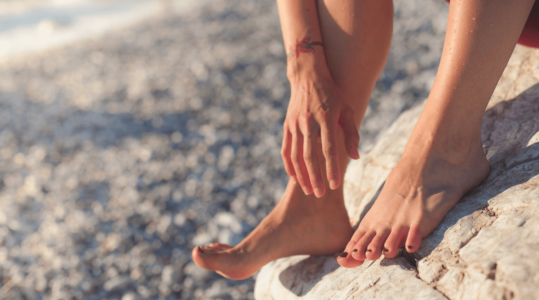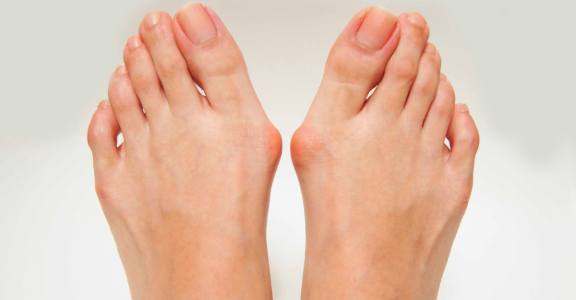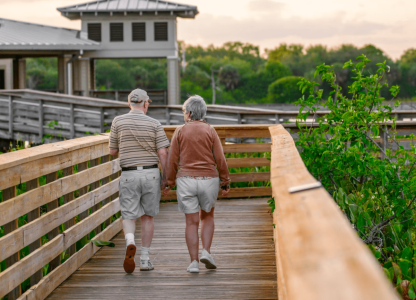Sole Searching: The Ultimate Guide to Understanding and Managing Bunions
- Replies 8
Do you ever feel like your feet are rebelling against you? Perhaps you've noticed a bump forming at the base of your big toe, or maybe you're experiencing pain and swelling in that area.
If so, you might be dealing with bunions — a common foot deformity that affects up to 80 per cent of Australia's older population.
But fear not because, in this article, we'll give you the lowdown on bunions: what they are, what causes them, how to prevent them, and how to treat them if you're already dealing with them.
So sit back, relax, put your feet up (carefully, of course), and prepare to be informed!

So, what are bunions?
You might have heard that painful bump on your foot referred to as a Hallux Valgus, which is the medical name for this condition.
Put simply, bunions form when the joint of the big toe moves out of place due to pressure and forms a bulging lump. If you have it at the base of your little toe, it's called a bunionette.
The most common symptoms are often swelling, redness or soreness around the big toe joint, thick skin on the underside of your big toe, and calluses on your second toe (often caused by the big toe and second toe overlapping).
If left untreated, bunions can lead to persistent foot pain and difficulty walking, running, or performing daily activities.

What causes them?
Have you ever wondered why some people seem to be more prone to developing bunions than others? Well, it turns out that your foot type and family history may play a big role!
While the exact cause of bunions is still a bit of a mystery, experts believe that certain foot types, combined with years of abnormal pressure on the big toe joint, are a recipe for bunion disaster. This is often exacerbated by wearing shoes that crowd the toes, like those trendy but oh-so-painful high heels or narrow-toed women's shoes.
Unfortunately, women tend to be at a higher risk for bunions because many of their shoe styles are designed to look fashionable, not feel comfortable.
So, if you're a fashion shoe-lover, it's important to be extra mindful of the pressure you're putting on your feet.

What can older adults do to avoid bunions?
First and foremost, make sure you're wearing shoes that fit properly - think cosy and supportive, not tight and constricting. Also, make sure to choose the right size, as shoes that are too small can put undue pressure on your toes and lead to bunion formation.
Keeping active and performing regular foot stretches and exercises is also key. Even a quick walk around the block daily can help keep your feet and toes limber and healthy.
But if you're already suffering from bunions, don't fret! There are plenty of treatment options available to help alleviate the pain. Be sure to consult with a podiatrist or medical professional to discuss your options, which could include custom orthotics or pads, bunion pads, or even surgery in some cases.
My bunion hurts. What should I do?
If you're experiencing acute discomfort, there are a few self-care strategies you can try to help find some relief.
First off, remove those shoes and give your feet a break! Elevating your feet can help reduce pressure and inflammation, which can alleviate some of the discomfort.
If the pain and swelling are really bad, try applying an ice pack for several 10 to 15-minute sessions daily. Be sure to move the ice pack around and place a thin towel between the pack and your skin to prevent any ice burns.
For a more gentle approach, soaking your feet in cool (not icy) water can help reduce swelling. If you're experiencing stiffness in the big toe joint, try using a warm foot bath or a moist, steamed towel instead.
Lastly, don't forget to stretch those feet! Performing a simple set of routine exercises can help keep your feet flexible and avoid stiffness, which can lead to even more pain down the line.
If that didn’t work, there are a few other tricks you can try to help alleviate some of the discomfort.
One option is to pad the bunion from the outside. Bunion pads ($9.69 at Chemist Warehouse) are available at most chemists and come in a variety of materials, including moleskin, neoprene, foam, silicone, and gel-filled plastic.
These pads work by lessening the pressure placed on the bunion while wearing shoes and tend to be most effective when paired with shoes that have a wide toe box. Most bunion pads are applied with a removable adhesive strip, but some are even woven into the fabric of special removal booties!
Another option is to try forcing your toes into a more natural position. This can be done using a toe spacer, which slips between the toes to help keep them separated and aligned. Toe spacers ($8.99 at Chemist Warehouse) can be particularly helpful for those with mild to moderate bunions, as they can help prevent the bunion from worsening over time.
Of course, if your bunion pain is severe or doesn't improve with these self-care strategies, it's always a good idea to consult with a podiatrist or other medical professional to discuss your treatment options.
Credit: Melbourne Muscular Therapies.
When should I see a doctor?
You should definitely seek medical attention if you're experiencing significant pain, swelling, or stiffness in your feet or if your bunions are interfering with your ability to walk or engage in daily activities.
In some cases, podiatrists may refer their patients to a physical therapist who specialises in treating foot conditions. Physical therapy can be a great way to ease inflammation and bunion pain, and one common technique used by physical therapists is ultrasound therapy.
However, if your bunion pain is severe or persistent despite conservative treatments, your healthcare provider may recommend surgery. The goal of bunion surgery is typically to alleviate pain and correct any deformity caused by the bunion.
While surgery is generally considered a last resort, it can be a highly effective way to manage severe bunions and improve your quality of life.

Bunions can be a real pain, but with proper care and attention, you can take steps to prevent or manage them. Remember to wear comfortable and supportive shoes that fit properly, stay active and perform regular foot exercises, and seek medical advice if your bunions are causing significant pain or affecting your daily activities.
What are your thoughts on this topic, members? Have you experienced bunions before? What self-care strategies have you found to be most effective? Share your tips and experiences in the comments below!
If so, you might be dealing with bunions — a common foot deformity that affects up to 80 per cent of Australia's older population.
But fear not because, in this article, we'll give you the lowdown on bunions: what they are, what causes them, how to prevent them, and how to treat them if you're already dealing with them.
So sit back, relax, put your feet up (carefully, of course), and prepare to be informed!

Bunions are a common and painful foot condition affecting more than 80 per cent of older adults in Australia. Credit: Unsplash/Jan Romero.
So, what are bunions?
You might have heard that painful bump on your foot referred to as a Hallux Valgus, which is the medical name for this condition.
Put simply, bunions form when the joint of the big toe moves out of place due to pressure and forms a bulging lump. If you have it at the base of your little toe, it's called a bunionette.
The most common symptoms are often swelling, redness or soreness around the big toe joint, thick skin on the underside of your big toe, and calluses on your second toe (often caused by the big toe and second toe overlapping).
If left untreated, bunions can lead to persistent foot pain and difficulty walking, running, or performing daily activities.

Bunions develop when the joint of the big toe moves out of place due to pressure, causing a bulging bump and the toe pointing outward. Credit: Facebook/American Podiatric Medical Association (APMA).
What causes them?
Have you ever wondered why some people seem to be more prone to developing bunions than others? Well, it turns out that your foot type and family history may play a big role!
While the exact cause of bunions is still a bit of a mystery, experts believe that certain foot types, combined with years of abnormal pressure on the big toe joint, are a recipe for bunion disaster. This is often exacerbated by wearing shoes that crowd the toes, like those trendy but oh-so-painful high heels or narrow-toed women's shoes.
Unfortunately, women tend to be at a higher risk for bunions because many of their shoe styles are designed to look fashionable, not feel comfortable.
So, if you're a fashion shoe-lover, it's important to be extra mindful of the pressure you're putting on your feet.

A simple walk around the block can do wonders for your foot health. Credit: Unsplash/Richard Sagredo.
What can older adults do to avoid bunions?
First and foremost, make sure you're wearing shoes that fit properly - think cosy and supportive, not tight and constricting. Also, make sure to choose the right size, as shoes that are too small can put undue pressure on your toes and lead to bunion formation.
Keeping active and performing regular foot stretches and exercises is also key. Even a quick walk around the block daily can help keep your feet and toes limber and healthy.
But if you're already suffering from bunions, don't fret! There are plenty of treatment options available to help alleviate the pain. Be sure to consult with a podiatrist or medical professional to discuss your options, which could include custom orthotics or pads, bunion pads, or even surgery in some cases.
My bunion hurts. What should I do?
If you're experiencing acute discomfort, there are a few self-care strategies you can try to help find some relief.
First off, remove those shoes and give your feet a break! Elevating your feet can help reduce pressure and inflammation, which can alleviate some of the discomfort.
If the pain and swelling are really bad, try applying an ice pack for several 10 to 15-minute sessions daily. Be sure to move the ice pack around and place a thin towel between the pack and your skin to prevent any ice burns.
For a more gentle approach, soaking your feet in cool (not icy) water can help reduce swelling. If you're experiencing stiffness in the big toe joint, try using a warm foot bath or a moist, steamed towel instead.
Lastly, don't forget to stretch those feet! Performing a simple set of routine exercises can help keep your feet flexible and avoid stiffness, which can lead to even more pain down the line.
If that didn’t work, there are a few other tricks you can try to help alleviate some of the discomfort.
One option is to pad the bunion from the outside. Bunion pads ($9.69 at Chemist Warehouse) are available at most chemists and come in a variety of materials, including moleskin, neoprene, foam, silicone, and gel-filled plastic.
These pads work by lessening the pressure placed on the bunion while wearing shoes and tend to be most effective when paired with shoes that have a wide toe box. Most bunion pads are applied with a removable adhesive strip, but some are even woven into the fabric of special removal booties!
Another option is to try forcing your toes into a more natural position. This can be done using a toe spacer, which slips between the toes to help keep them separated and aligned. Toe spacers ($8.99 at Chemist Warehouse) can be particularly helpful for those with mild to moderate bunions, as they can help prevent the bunion from worsening over time.
Of course, if your bunion pain is severe or doesn't improve with these self-care strategies, it's always a good idea to consult with a podiatrist or other medical professional to discuss your treatment options.
Credit: Melbourne Muscular Therapies.
When should I see a doctor?
You should definitely seek medical attention if you're experiencing significant pain, swelling, or stiffness in your feet or if your bunions are interfering with your ability to walk or engage in daily activities.
In some cases, podiatrists may refer their patients to a physical therapist who specialises in treating foot conditions. Physical therapy can be a great way to ease inflammation and bunion pain, and one common technique used by physical therapists is ultrasound therapy.
However, if your bunion pain is severe or persistent despite conservative treatments, your healthcare provider may recommend surgery. The goal of bunion surgery is typically to alleviate pain and correct any deformity caused by the bunion.
While surgery is generally considered a last resort, it can be a highly effective way to manage severe bunions and improve your quality of life.
Key Takeaways
- Bunions are a common foot deformity that often cause pain and discomfort, especially in older adults.
- They are typically caused by a combination of genetics and abnormal pressure on the big toe joint, often from ill-fitting shoes.
- Self-care strategies like wearing comfortable shoes, performing foot exercises, and using bunion pads can provide some relief, but severe or persistent bunion pain may require medical attention, including physical therapy or surgery.
Bunions can be a real pain, but with proper care and attention, you can take steps to prevent or manage them. Remember to wear comfortable and supportive shoes that fit properly, stay active and perform regular foot exercises, and seek medical advice if your bunions are causing significant pain or affecting your daily activities.
What are your thoughts on this topic, members? Have you experienced bunions before? What self-care strategies have you found to be most effective? Share your tips and experiences in the comments below!








